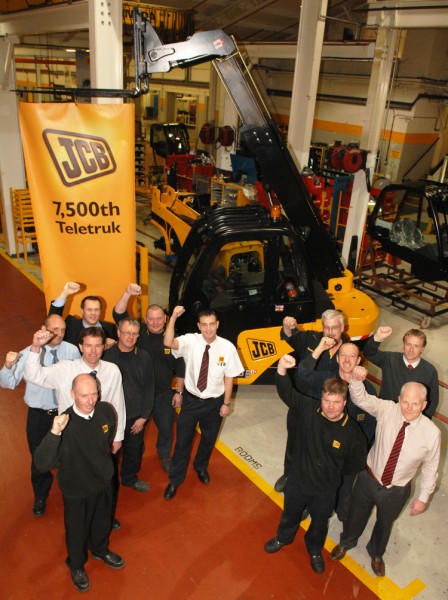 JCB celebrates the production of the 7,500th Teletruk forklift. |
JCB has celebrated a milestone with the production of its 7,500th Teletruk industrial forklift.
Launched in the UK in 1997, the forklift's appeal has since spread to customers across the world including South Africa, Brazil and the US. The forklift's newest export dealers are in New Zealand and Australia.
The machine, produced at JCB Utility Products in Cheadle, Staffordshire, was launched after almost two years of secret development work.
The Teletruk uses the telescopic boom well-known on larger JCB Loadall telescopic handlers. The boom is fitted to a small chassis with a rear counterweight, enabling the machine to lift loads up to 3.5 tonnes.
The machine's forward reach capability allows single-side loading, saving up to 50% loading space in congested yards, reaching over obstacles in yards and reaching into transit-type vans. It can also reach into ships, ferries and railway carriages from quaysides and platforms. Used with a range of over 3,000 different attachments, the Teletruk has a maximum lift height of 5.15 metres (16.9 feet) and a maximum forward reach of 3.3 metres (10.8 feet).
JCB industrial general manager Chris Nowell says the milestone is a huge achievement for a "unique JCB product" now found around the world.
"Its appeal has grown because of its ability to do what ordinary forklifts cannot by virtue of its telescopic boom," he says.
Most of the Teletruks produced are four-wheel drive. Today, the forklifts are used in industries as diverse as agriculture, waste, ports, airports and fish farms.
Separately, JCB has donated two 3CX backhoe loaders worth USD150,000 to help the disaster relief in Haiti following the earthquake that has killed tens of thousands of people.
JCB chairman Anthony Bamford made the gift in response to an appeal from relief agencies for foreign aid. "There is clearly a lack of equipment on the island and I hope our gift of JCB machines will help in some small way to alleviate the suffering and in the rebuilding in the aftermath of the earthquake," Bamford says.
The machines are being made available to the US government, which is taking a leading role in the relief effort on the Caribbean island.